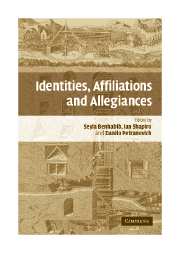Book contents
- Frontmatter
- Contents
- List of figures
- List of tables
- List of contributors
- Editors' introduction
- Part I Emergence and limits of national political identities
- 1 From affiliation to affinity: citizenship in the transition from empire to the nation-state
- 2 Transnationalizing the public sphere: on the legitimacy and efficacy of public opinion in a post Westphalian world
- 3 “Being there”: place, territory, and identity
- 4 Political boundaries in a multilevel democracy
- Part II Multiple identities in practice: the European example
- Part III Decoupling citizenship from identity
- Part IV Identity and historical injustice
- References
- Index
3 - “Being there”: place, territory, and identity
Published online by Cambridge University Press: 05 June 2012
- Frontmatter
- Contents
- List of figures
- List of tables
- List of contributors
- Editors' introduction
- Part I Emergence and limits of national political identities
- 1 From affiliation to affinity: citizenship in the transition from empire to the nation-state
- 2 Transnationalizing the public sphere: on the legitimacy and efficacy of public opinion in a post Westphalian world
- 3 “Being there”: place, territory, and identity
- 4 Political boundaries in a multilevel democracy
- Part II Multiple identities in practice: the European example
- Part III Decoupling citizenship from identity
- Part IV Identity and historical injustice
- References
- Index
Summary
Introduction: spatiality and social identity
The question taken up in this chapter is simple: what do notions of place and space (the field of potential places) have to do with identity? Most of us would answer: a great deal. We define ourselves at least partly in terms of where we are from; we experience feelings of displacement that suggest how important must be the usually ignored signals testifying to emplacement. But, of course, the question can get complicated, first with respect to the elusive concept of identity and then with respect to the multiple meanings of place.
I shall not spend much time worrying about the meaning of identity except to note that in general usage it applies to at least two different types of subject or psychological orientations. Our inner personal identity seems based on an awareness of persistence through time: it expresses the individual's psychic continuity across the years and its major instrument is personal memory. If memory disintegrates, it is difficult to assert personal identity. Individual identity thus has an underlying temporal dimension. It builds the self in the present moment from memories of past moments. Ultimately it is limited by boundaries of time (i.e. death) and not of space. These are the issues, of course, pre-eminently explored by Heidegger and other existential philosophers.
In contrast to personal identity, group or collective “identity” is constructed out of a synchronic web of affiliations and sentiments. It expresses individuals' sense of belonging within a society or community.
- Type
- Chapter
- Information
- Identities, Affiliations, and Allegiances , pp. 67 - 84Publisher: Cambridge University PressPrint publication year: 2007
- 8
- Cited by

